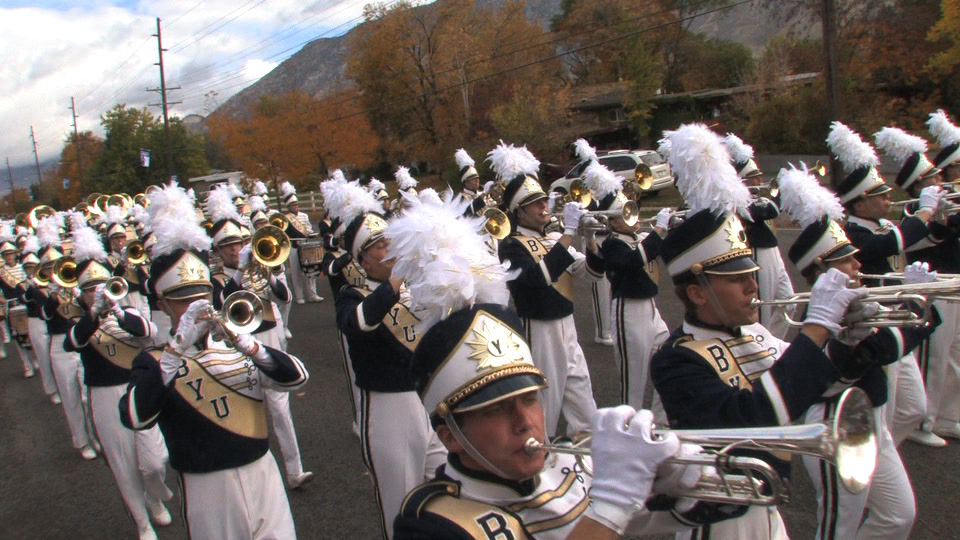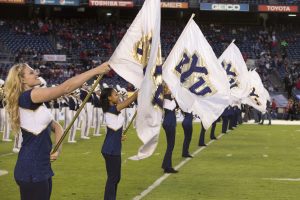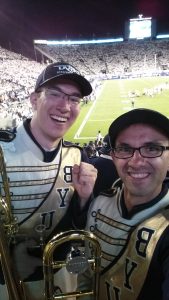
Hundreds of students audition to be a part of the BYU Cougar Marching Band, affectionately nicknamed “the power of the Wasatch,” each year.
Students must go through a rigorous audition process before being admitted into the Cougar Marching Band and BYU Color Guard.
Cougar Marching Band auditions were open starting April 15 through May 1. Those who have auditioned will find out whether they were accepted starting on May 15.
The color guard’s first live auditions took place on April 8. Color guard has another live audition on July 8 and a video submission deadline on July 10 for those who can’t attend in person.
Students started the audition online by filling out an “Intent to Audition” form that asks for some personal information as well as the applicant’s area of interest for the audition.
The applicants then received an email with more detailed information regarding the audition requirements for the band or for color guard.

Band applicants typically submitted a 5-minute recording of the required audition material. This included scales and pieces to show their range and skill on their instrument. While most applicants can choose their own pieces that fulfill the requirements, those who applied for the more competitive sections, like drumline or piccolo, were required to use material distributed by BYU.
Color guard applicants attend live auditions under the direction of BYU Color Guard Director Ashlee Chatterton. Chatterton said the process included a clinic covering movement and flag technique. Applicants were then taught a routine they used to audition with at the end of the day.
Once accepted into the band or color guard, students sign up for the marching band class, which meets for 6 hours each week. Color guard has additional practices because they meet an hour before each rehearsal to learn choreography.
Music for the upcoming season is sent out to band members during the summer so they can start learning and memorizing before they meet for their first rehearsal the week before fall semester starts.
Karren Williamson, the administrative assistant for the BYU Bands, said the marching band learns about three halftime shows a season as well as learning music that’s played before and during the football games.
All members of the band and color guard receive a talent award scholarship. The scholarships start at around $600 for fall semester, but students are eligible for higher amounts depending on music major status, leadership positions in the band and other experiences.
Marching band participants Samuel Ward and Angela Kimball said they enjoy the experience although it’s time-consuming.

Ward is a music education major with an instrumental emphasis. As a music education major who plays the trombone, he is required to take at least one semester of marching band. Ward was recently made squad leader overseeing about five fellow trombonists. This upcoming fall season will be his third season with the band.
“I love performing with the band, and it’s super fun to work with the people,” Ward said.
Kimball was in the color guard for 4 years prior to becoming the assistant advisor in 2016. Kimball said she loved the bond she had with the team.
“You all decided you wanted to be on the guard and you all become super good friends at the end,” Kimball said.
Ward said a general misconception about marching band is that people don’t understand what a drum major is. He said people often confuse drum major with snare captain. Snare captain is the captain over the drumline while drum major directs the marching band.
Chatterton said a common misconception about the color guard is its confusion with the ROTC or Military.
“Usually when you talk about color guard, you assume that it’s something to do with the ROTC or military versus something with the band,” Chatterton said. “It’s much more of a performing art and more of a dance team than more of a military team or group.”
Kimball’s advised the student body to pay attention to the marching band.
“Watch the marching band at half-time because they do really fun shows,” Kimball said. “They work really hard to put on the shows.”




